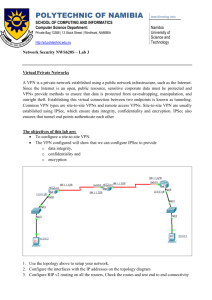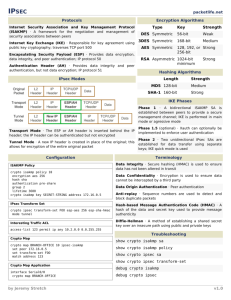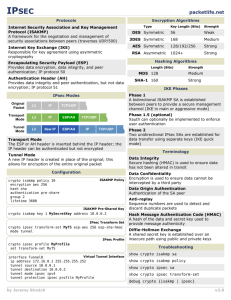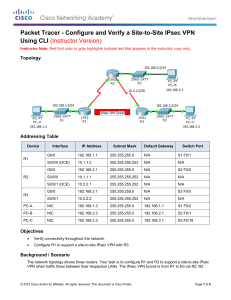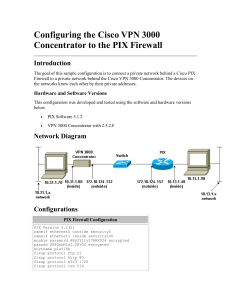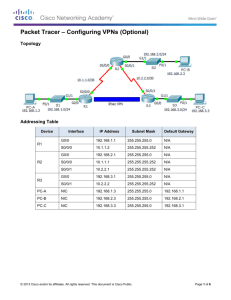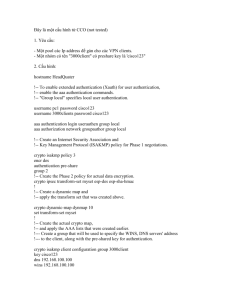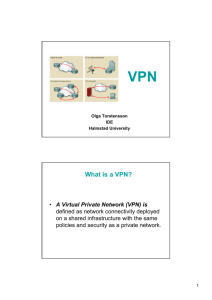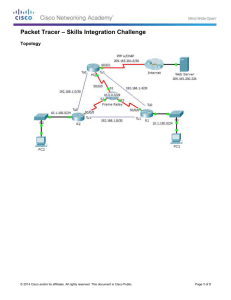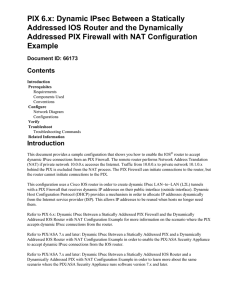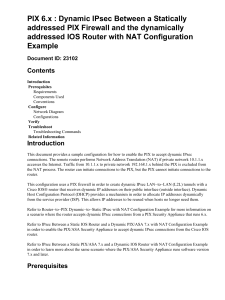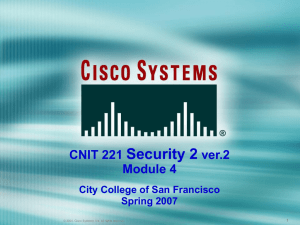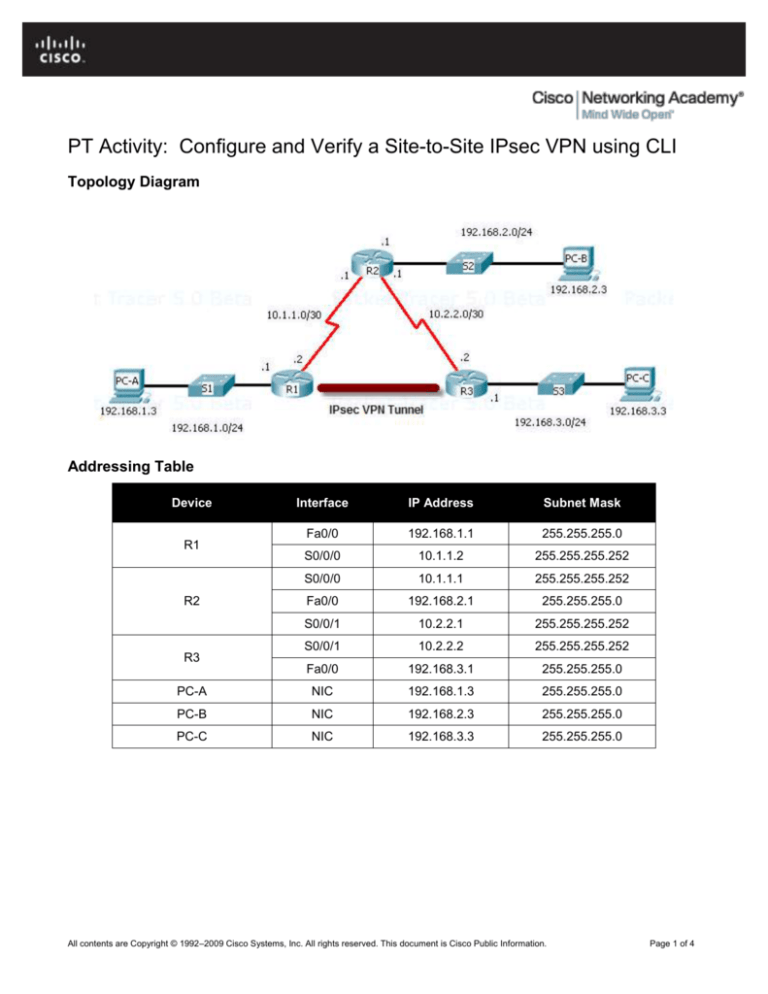
PT Activity: Configure and Verify a Site-to-Site IPsec VPN using CLI
Topology Diagram
Addressing Table
Device
Interface
IP Address
Subnet Mask
Fa0/0
192.168.1.1
255.255.255.0
S0/0/0
10.1.1.2
255.255.255.252
S0/0/0
10.1.1.1
255.255.255.252
Fa0/0
192.168.2.1
255.255.255.0
S0/0/1
10.2.2.1
255.255.255.252
S0/0/1
10.2.2.2
255.255.255.252
Fa0/0
192.168.3.1
255.255.255.0
PC-A
NIC
192.168.1.3
255.255.255.0
PC-B
NIC
192.168.2.3
255.255.255.0
PC-C
NIC
192.168.3.3
255.255.255.0
R1
R2
R3
All contents are Copyright © 1992–2009 Cisco Systems, Inc. All rights reserved. This document is Cisco Public Information.
Page 1 of 4
CCNA Security
Learning Objectives
Verify connectivity throughout the network.
Configure router R1 to support a site-to-site IPsec VPN with R3.
Introduction
The network topology shows three routers. Your task is to configure routers R1 and R3 to support a site-to-site
IPsec VPN when traffic flows from their respective LANs. The IPsec VPN tunnel is from router R1 to router R3
via R2. R2 acts as a pass-through and has no knowledge of the VPN. IPsec provides secure transmission of
sensitive information over unprotected networks such as the Internet. IPsec acts at the network layer, protecting
and authenticating IP packets between participating IPsec devices (peers), such as Cisco routers.
ISAKMP Phase 1 Policy Parameters
Parameters
R1
R3
Key distribution method
Manual or ISAKMP
ISAKMP
ISAKMP
Encryption algorithm
DES, 3DES, or AES
AES
AES
Hash algorithm
MD5 or SHA-1
SHA-1
SHA-1
Authentication method
Pre-shared keys or RSA
pre-share
pre-share
Key exchange
DH Group 1, 2, or 5
DH 2
DH 2
IKE SA Lifetime
86400 seconds or less
86400
86400
vpnpa55
vpnpa55
ISAKMP Key
Note:
Bolded parameters are defaults. Only unbolded parameters have to be explicitly configured.
IPsec Phase 2 Policy Parameters
Parameters
R1
R3
Transform Set
VPN-SET
VPN-SET
Peer Hostname
R3
R1
Peer IP Address
10.2.2.2
10.1.1.2
Network to be encrypted
192.168.1.0/24
192.168.3.0/24
Crypto Map name
VPN-MAP
VPN-MAP
SA Establishment
ipsec-isakmp
ipsec-isakmp
All contents are Copyright © 1992–2007 Cisco Systems, Inc. All rights reserved. This document is Cisco Public Information.
Page 2 of 4
CCNA Security
The routers have been pre-configured with the following:
Password for console line: ciscoconpa55
Password for vty lines: ciscovtypa55
Enable password: ciscoenpa55
RIP version 2
Task 1:
Step 1.
Configure IPsec parameters on R1
Test connectivity.
Ping from PC-A to PC-C.
Step 2.
Identify interesting traffic on R1.
Configure ACL 110 to identify the traffic from the LAN on R1 to the LAN on R3 as interesting. This interesting
traffic will trigger the IPsec VPN to be implemented whenever there is traffic between R1 to R3 LANs. All other
traffic sourced from the LANs will not be encrypted. Remember that due to the implicit deny all, there is no need
to configure a deny any any statement.
Step 3.
Configure the ISAKMP Phase 1 properties on R1.
Configure the crypto ISAKMP policy 10 properties on R1 along with the shared crypto key vpnpa55. Refer to
the ISAKMP Phase 1 table for the specific parameters to configure. Default values do not have to be configured
therefore only the encryption, key exchange method, and DH method must be configured.
Step 4.
Configure the ISAKMP Phase 2 properties on R1.
Create the transform-set VPN-SET to use esp-3des and esp-sha-hmac. Then create the crypto map VPNMAP that binds all of the Phase 2 parameters together. Use sequence number 10 and identify it as an ipsecisakmp map.
Step 5.
Configure the crypto map on the outgoing interface.
Finally, bind the VPN-MAP crypto map to the outgoing Serial 0/0/0 interface. Note: This is not graded.
R1(config)# interface S0/0/0
R1(config-if)# crypto map VPN-MAP
Task 2:
Step 1.
Configure IPsec Parameters on R3
Configure router R3 to support a site-to-site VPN with R1.
Now configure reciprocating parameters on R3. Configure ACL 110 identifying the traffic from the LAN on R3 to
the LAN on R1 as interesting.
Step 2.
Configure the ISAKMP Phase 1 properties on R3.
Configure the crypto ISAKMP policy 10 properties on R3 along with the shared crypto key vpnpa55.
Step 3.
Configure the ISAKMP Phase 2 properties on R3.
Like you did on R1, create the transform-set VPN-SET to use esp-3des and esp-sha-hmac. Then create the
crypto map VPN-MAP that binds all of the Phase 2 parameters together. Use sequence number 10 and identify
it as an ipsec-isakmp map.
Step 4.
Configure the crypto map on the outgoing interface.
Finally, bind the VPN-MAP crypto map to the outgoing Serial 0/0/1 interface. Note: This is not graded.
R1(config)# interface S0/0/1
All contents are Copyright © 1992–2007 Cisco Systems, Inc. All rights reserved. This document is Cisco Public Information.
Page 3 of 4
CCNA Security
R1(config-if)# crypto map VPN-MAP
Task 3:
Step 1.
Verify the IPsec VPN
Verify the tunnel prior to interesting traffic.
Issue the show crypto ipsec sa command on R1. Notice that the number of packets encapsulated, encrypted,
decapsulated and decrypted are all set to 0.
Step 2.
Create interesting traffic.
From PC-A, ping PC-C.
Step 3.
Verify the tunnel after interesting traffic.
On R1, re-issue the show crypto ipsec sa command. Now notice that the number of packets is more than 0
indicating that the IPsec VPN tunnel is working.
Step 4.
Create uninteresting traffic.
From PC-A, ping PC-B.
Step 5.
Verify the tunnel.
On R1, re-issue the show crypto ipsec sa command. Finally, notice that the number of packets has not
changed verifying that uninteresting traffic is not encrypted.
Step 6.
Check results.
Your completion percentage should be 100%. Click Check Results to see feedback and verification of which
required components have been completed.
All contents are Copyright © 1992–2007 Cisco Systems, Inc. All rights reserved. This document is Cisco Public Information.
Page 4 of 4

